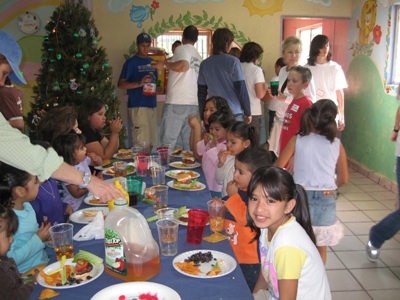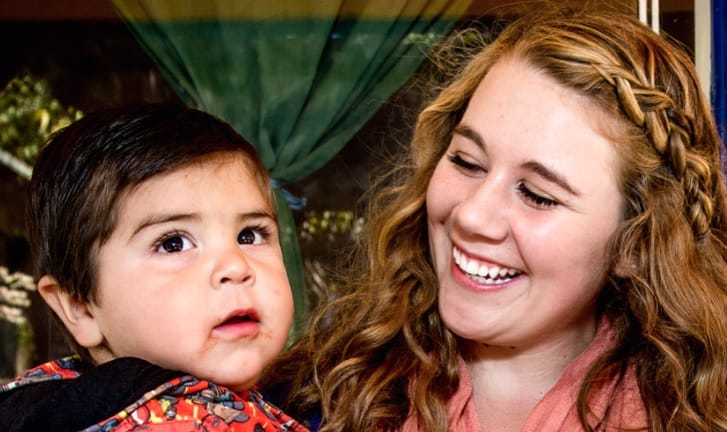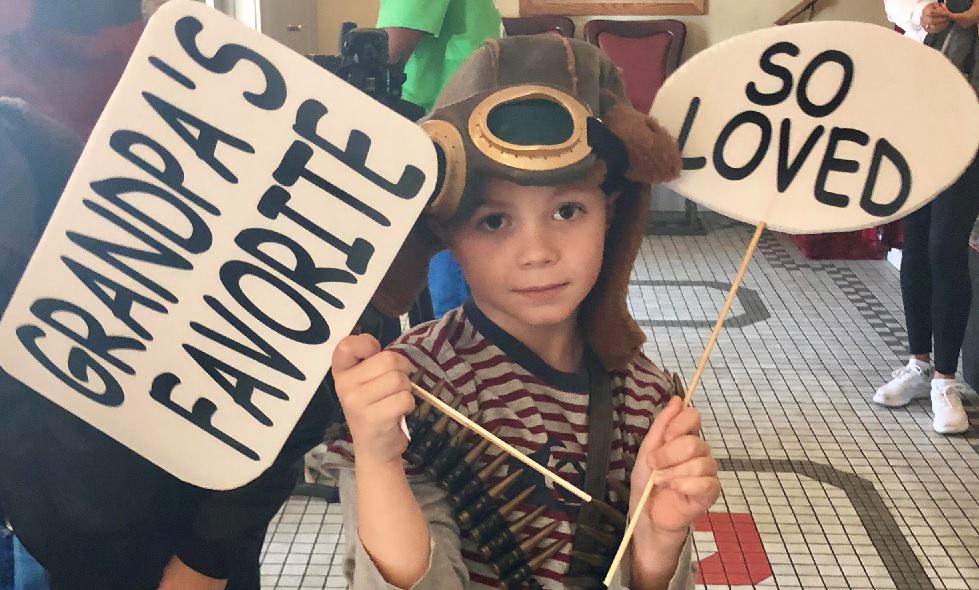 Corazon de Vida was created in 1994 as a Self-Expression and Leadership Program project by Hilda Pacheco-Taylor in Newport Beach, California. Corazon de Vida recently had its latest Child Sponsorship dinner and announced that it is now sponsoring 14 orphanages in Baja, Mexico.
Corazon de Vida was created in 1994 as a Self-Expression and Leadership Program project by Hilda Pacheco-Taylor in Newport Beach, California. Corazon de Vida recently had its latest Child Sponsorship dinner and announced that it is now sponsoring 14 orphanages in Baja, Mexico.
“Delivering hope”
Corazon de Vida, an Irvine-based charity supporting the struggling orphanages of Baja California, is making a difference for forgotten children.
By Marla Jo Fisher
THE ORANGE COUNTY REGISTER
A dozen small children clad in clean jeans and T-shirts press their faces against the chain-link fence, peering intently down at the busy highway below.
They see a bus turn uphill on the rutted dirt road toward them and all hell breaks loose.
“They’re here! They’re here!” the children scream, and begin running to the gate.
Inside the bus, the regulars begin gathering up their belongings, while trip director George Perez picks up the microphone and tells the newbies what to expect.
It’s 9:30 on Saturday morning, and the volunteer bus from Corazon de Vida, an Irvine-based charity, is making its monthly visit to El Faro orphanage in Tijuana.
El Faro, which means “The Lighthouse,” is one of the 14 orphanages in Baja California that Corazon de Vida supports, with donations that pay for food and utilities for 700 children. With no government funding, children’s homes here survive strictly on private donations.
After climbing uphill for a half-mile, the bus can’t make it back down the final steep dirt road to the orphanage, which clings precariously to a cliff overlooking the busy highway to Tecate. Instead, the 55 people aboard get out and walk the last quarter-mile, through a dusty, trash-strewn shantytown of shelters made from plywood and tin.
“Be careful when you get off the bus,” Perez warns. “The road here is steep and you can lose your footing.”
Roosters crow and scrawny dogs bark, as the volunteers kick up dust on the rutted track, hauling bags of diapers, laundry soap, mops and brooms down the hill.
This home, built on a landfill made from old tires, will someday slide down the hill and be pulverized on the highway below. Every storm, a few tires are displaced.
Perez and his colleagues at Corazon de Vida hope to someday raise the money to move the facility to more stable ground, preferably before an earthquake or mudslide moves it for them.
But on this day, the 70 children joyfully pounce on the visitors as soon as they walk in the door. Some search out their favorite people. Others leap into the arms of strangers.
People have brought balloons, games, books and face-painting supplies. Visitors aren’t allowed to bring toys, because of the home’s extreme need for other, more basic staples of life, nor candy, which will lead to dental visits.
Mostly, the children just crave contact with adults other than caregivers worn out from cooking, cleaning and supervising.
“These kids are so loving towards us, it’s like they give more to us than we can give to them,” said Concordia University student Stephanie Warren as she sat on the dirt floor holding a sleeping child.
Volunteers aren’t allowed to be alone with the children, but they are encouraged to hold them, touch them, give them piggyback rides.
“Please do not take any kids home with you,” Perez jokes with the visitors. “I know you want to.
CHILDREN LIVING ALONE ON THE STREETS
No one is quite sure exactly how many private orphanages are operating in Baja California. Though these establishments are called orphanages, most of the children’s parents are alive. Some kids have been abandoned. In other cases, parents are simply too poor and desperate to keep them.
The Mexican government estimates some 6,000 children are living on the streets in the Tijuana area, though other researchers have put that count as high as 20,000.
Sometimes, kindhearted people take in one or two street children, then a group of siblings. Before they know it, they’re running an orphanage.
Children have been rescued foraging for food in the city dump. One woman took in three little girls she found living under a car after their mother died. Some migrants making their way to the U.S. leave their children behind at orphanages, planning to return someday to collect them. Other kids have parents who are prostitutes or drug addicts.
While the Mexican government will pick up street children, it must look for places to put them in private homes, since there is no government system of foster care. Adoption is difficult and discouraged.
“An orphanage is actually like Camelot – it’s ideal,” Perez said. “It’s the ultimate location.”
The Mexican family welfare agency, DIF, inspects private orphanages but does not provide any financial support. There are not nearly enough beds for all the children on the streets.
“The government won’t admit how bad it is, I don’t think you can get a straight answer,” Dick Hagerty, who was appointed in the 1980s by then-Lt. Gov. Mike Curb to the now-defunct Commission of the Californias, which looked at issues affecting California, Baja California and the southern state of Baja, Baja California Sur.
At El Faro’s ranch in the country, where teenagers live to keep them away from urban temptations, Perez found two boys from Orange County who had been brought across the border and then abandoned by their mother. “When I met them, I asked them, “Why do you speak such good English?” And they said, “Because we’re Americans.”
He arranged for the boys to be returned to Orange County, where they are living at Orangewood Children’s Home.
He also found a teenage girl, raised in Illinois but born in Mexico, whose mother brought her to Tijuana and abandoned her there. Wandering the streets, hungry and alone, the girl stumbled onto El Faro and asked for help.
Because she’s not a legal resident of the U.S., the girl can’t return, but Perez volunteered to find her family and let them know where she was. Now, an aunt is seeking to adopt her and bring her back to Illinois.
HER MOTHER NEVER CAME BACK
In one small, tidy dormitory at El Faro, the girls sleep on seven sets of pink bunk beds with worn sheets.
The lucky ones have pillows, under which they hide their meager cache of personal possessions – the only private space they own.
Some visitors have brought small plastic pencil boxes, which the children can use to store their cherished items.
Perez stops to talk to one child, who tugs at his arm.
“Her mother dropped her off two years ago and never came back,” Perez says. “She keeps telling me her mother is coming back for her.” He shakes his head sadly.
Six-year-old Lupita also demands his attention. She wants to go to school like her friends, but she can’t because she has no papers. Her father dropped her off without a birth certificate, which is required to enroll in Mexican schools.
El Faro sends its kids to school an hour away by bus, because the home gets a discount on fees. Although primary education is compulsory in Mexico through sixth grade, it costs about $80 a month to send a child to school including uniforms and supplies.
Children only go to high school if they have a sponsor willing to pay their fees.
The founder of Corazon de Vida, Hilda Pacheco-Taylor, knows all about the struggles that Baja orphanages face. Today, she’s a successful Irvine executive. But 35 years ago, she was one of those children.
“I was 8 years old when our mother placed us in the Puerto de Fe orphanage,” Pacheco-Taylor recalled. “She didn’t want to, but she thought we would be safer there.”
Her father, a barber, abandoned the family, leaving Pacheco-Taylor’s mother struggling to support four children by making tortillas. At 8, Pacheco-Taylor cared for her younger siblings while her mother went to work. But when her brother almost drowned, her mother thought they would be better off in a children’s home.
Later, her mother made her way to the United States and got work as a laundress.
Pacheco-Taylor lived in the children’s home until age 16, when she left the home and made her own way to join her mother in Orange County. The family later gained legal residence through an amnesty program.
Today, Pacheco-Taylor is vice president of operations for L5 Performance Systems in Irvine and married with grown children.
But she has never forgotten Puerto de Fe. On one visit, she discovered the home had shrunk in size and the children were ill-fed and tattered. That spurred her to action.
Initially, she intended to just find some financial sponsors. But she ultimately formed a nonprofit corporation that today helps not only her childhood home, but 13 others.
These days, people like George Perez have joined the cause.
A former computer consultant, Perez was dragged on a visit by a girlfriend years ago. Touched by the children, he began volunteering and ultimately sold his house in Los Angeles and moved to Dana Point to be closer to Baja.
Now, he works for the nonprofit, supervising the orphanage contacts, organizing cooperatives to get a better price on gas, utilities, milk and fresh produce.
On the visit to El Faro, it was Perez’s birthday and the orphanage gave him a cake, along with the residents who also had birthdays that month.
While on the bus driving down there, Perez got a call on his cell phone. It was children from another orphanage, singing him “Happy Birthday” en masse.
“I couldn’t imagine a better way to spend my birthday,” Perez said, beaming.




3 comments
i think what they are doing is good for the kids. they need some place to go. i feel bad for the orphans. if i could take then in i would.
Is there any phone, mail or website where I can get a hold or reach Corazon de Vida foundation or Hilda Pacheco Taylor. There are some people interest in doing some donations for orphanages in Ensenada or Los Cabos
Thanks
Lourdes
[…] as her project in Landmark Education's self-expression in Leadership Program back in 1994 (see Landmark Education News' original story about the project). Since then, she has raised $5.5 million for the 14 […]